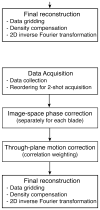Multishot PROPELLER for high-field preclinical MRI
- PMID: 20572138
- PMCID: PMC3391749
- DOI: 10.1002/mrm.22376
Multishot PROPELLER for high-field preclinical MRI
Abstract
With the development of numerous mouse models of cancer, there is a tremendous need for an appropriate imaging technique to study the disease evolution. High-field T(2)-weighted imaging using PROPELLER (Periodically Rotated Overlapping ParallEL Lines with Enhanced Reconstruction) MRI meets this need. The two-shot PROPELLER technique presented here provides (a) high spatial resolution, (b) high contrast resolution, and (c) rapid and noninvasive imaging, which enables high-throughput, longitudinal studies in free-breathing mice. Unique data collection and reconstruction makes this method robust against motion artifacts. The two-shot modification introduced here retains more high-frequency information and provides higher signal-to-noise ratio than conventional single-shot PROPELLER, making this sequence feasible at high fields, where signal loss is rapid. Results are shown in a liver metastases model to demonstrate the utility of this technique in one of the more challenging regions of the mouse, which is the abdomen.
(c) 2010 Wiley-Liss, Inc.
Figures






References
-
- Marzola P, Osculati F, Sbarbati A. High field MRI in preclinical research. Eur J Radiol. 2003;48(2):165–170. - PubMed
-
- Hedlund LW, Cofer GP, Owen SJ, Allan Johnson G. MR-compatible ventilator for small animals: computer-controlled ventilation for proton and noble gas imaging. Magn Reson Imaging. 2000;18(6):753–759. - PubMed
-
- Pipe JG. Motion correction with PROPELLER MRI: application to head motion and free-breathing cardiac imaging. Magn Reson Med. 1999;42(5):963–969. - PubMed
-
- Malisch TW, Hedlund LW, Suddarth SA, Johnson GA. MR microscopy at 7. 0 T: effects of brain iron. J Magn Reson Imaging. 1991;1(3):301–305. - PubMed
Publication types
MeSH terms
Grants and funding
LinkOut - more resources
Full Text Sources
Medical

